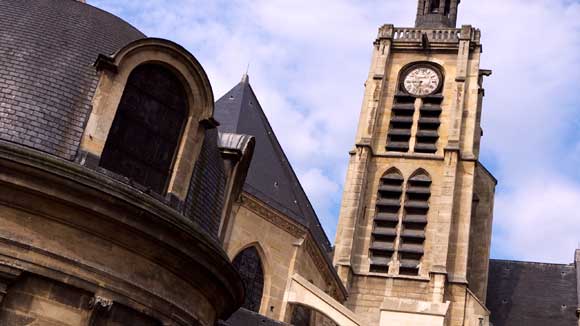“It was the best of times; it was the worst of times.”(1) “A Tale of Two Cities” begins in 1775 and spans 17 years of revolutionary turmoil in Paris, and comparative peace in London. It is the story of two men who both love one woman.
The woman, Lucie Manette is young, beautiful and vivacious. The first man is Charles Darnay. Darnay loves Lucie, and eventually he marries her. The second man is Sydney Carton. Carton, a London lawyer, is hard-drinking, cynical and irresponsible; but his love for Lucie will make him a hero.
The two men meet when Charles Darnay is tried for treason against the English Crown. Sydney Carton wins Darnay’s release when he points out to the jury that that he himself bears an uncanny resemblance to the defendant. This confuses the witnesses, and totally undermines the prosecutions case.
Now jump ahead to 1789 and the time of French Revolution. In London, all three of our major characters are happy and safe. Charles Darnay and Lucie are married; and Sydney Carton, who continues to love Lucie, has become the friend of both. Then their peace is disrupted. Charles Darnay travels to Paris to rescue a friend who is being held in the Bastille, but Darnay himself is discovered, imprisoned and sentenced to die.
When Sydney Carton learns of Charles Darnay’s plight, for the sake of Lucie and Charles, who is the source of Lucie’s happiness, he travels to Paris, and visits Darnay in the Bastille. Once more relying on their uncanny resemblance, Carton persuades Darnay to change clothes with him. Sydney Carton then sends Charles Darnay back to Lucie, while he waits in Darnay’s cell to be executed. I am sure that you will remember the line that Sydney Carton speaks as he is being conveyed to his death on behalf of another. It is one of the great lines in all of literature. He says, “It is a far, far better thing that I do, than I have ever done.” (2)
The Bible also tells “A Tale of Two Cities.” separated not by distance and geography, but by time and eternity. In his book, “Jerusalem: The Biography,” Simon Sebag Montefiore writes, “Jerusalem is the only city to exist twice—-in heaven and on earth.” (3) Likewise, in Galatians 4 St. Paul refers to both cities saying that one is located below, in this world, and the other is located above, in the presence of God.
The earthly and temporal Jerusalem is one of the oldest cities on our planet. The earliest part of the city was settled more than 4,000 years before the Birth of Christ. According to the Bible it was King David who made Jerusalem the capital of a United Israel; and it was David’s son, King Solomon, who added to the Jerusalem’s glory by building the 1st temple. Perhaps you remember Solomon’s prayer of dedication, “O, Lord, heaven and the highest heaven cannot contain your glory; how much less this house which I have built!” Solomon continues by asking that God have regard for the temple, which he has built, and hear all the prayers of all the people that are offered there, and answer them! (1st Kings 8:27-30) Under Israel’s greatest kings, Jerusalem became not only the religious epicenter of the nation, but also a powerhouse of trade in the ancient near east.
Of course all has not been Peaches & Cream for the city. During its long history, Jerusalem has been attacked 52 times, besieged 23 times, captured and recaptured 44 times, and destroyed twice. In 587 B.C. King Nebuchadnezzar plundered and destroyed for the city for the first time, and Solomon’s Temple was razed. King Zedekiah watched as his sons were slain before him, then he was blinded, and carried off in chains along with all the rest of Israel’s nobility. (2nd Kings 25:7) During this “Babylonian Captivity,” only a handful of people continued to live where the great city had once stood, and they lived at the margins of existence. Then seventy years later, with the patronage of King Cyrus the Great of Persia (Ezra 1) who defeated the Babylonians, Nehemiah, the governor and Ezra the scribe, led the people home. (Ezra/Nehemiah) They rebuilt Jerusalem, and its walls, and of course, the temple. The 2nd temple was completed in 516 BC, and it would stand for more than 500 years.
Jesus and his disciples prayed and worshiped in the 2nd Temple. Following his triumphal entry into Jerusalem, on the back of a colt, the foal of an ass, (4) Jesus cleansed the temple of those who bought and those who sold. He said that God intended the temple to be “a house of prayer for all nations,” (Isaiah 56:7) but they had made it a den of robbers
Jesus honored the temple, but Jesus did not regard the physical building as an essential. For instance, in Mark 13:1-2, we read that, one day, as Jesus and his disciples came out of the temple, one of his disciples said to him, “Look, Teacher, what wonderful stones and what wonderful buildings!” And Jesus said to him, “Do you see these great buildings? There will not be left here one stone upon another, that will not be thrown down.”(5)
The prophecy of Jesus was horribly fulfilled n 70 AD, when the man who would become Tiberius Caesar, laid siege to the city with three Roman Legions. The city became a killing ground. Tens of thousands of people died in battle, and from starvation, and from treachery. Many tried to flee the city. The Romans captured some them, and ripped open their bowels, because many had swallowed their money, in an attempt to hide it. Others were crucified. We sometimes think of the crucifixion of Jesus as an isolated incident. It was not. During the siege of Jerusalem the Romans crucified so many Jews that there was no room left on the Mount of Olives for more crosses, and no more trees from which to make them. Interestingly, Tiberius tried to save the temple; but he lost so many troops trying to save it that eventually he had it burned, and then his army razed it stone by stone.
The temple has never been rebuilt, nor can it be. In 691 AD the Muslims built “the dome of the Rock,” on the place where the temple once stood. They regard it as the gateway to paradise. If the Jews ever tried to tear down it down they would unleash total war with a people that outnumber them 1,000 to 1.( 6)
So, we have looked at the earthly Jerusalem, but what about the heavenly one?
In Hebrews 11:10 the writer envisions a heavenly city, which has foundations, whose Builder and Maker is God. In Galatians 4:26 St. Paul says that “the Jerusalem that is above is free, and she is our mother.” In the Jewish faith, the citizenship of a person is determined not by the father but by the mother. Paul means that all who belong to Jesus Christ are already citizens of the heavenly city. Thus in Philippians 3:20 he writes:
20 …. our commonwealth (citizenship KJV) is in heaven, and from it we await a Savior, the Lord Jesus Christ, 21 who will change our lowly body to be like his glorious body…”
Finally, in the Book of Revelation, at the time of Christ’s return in glory, the prophet sees the New Jerusalem coming down from heaven from God, prepared as a bride adorned for her husband. And, as the city is revealed, he hears a voice from the throne saying:
Behold, the dwelling of God is with men. He will dwell with them, and they shall be his people, and God himself will be with them; he will wipe away every tear from their eyes, and death shall be no more, and neither shall there be mourning nor crying nor pain anymore, for the former things have passed away.
The prophet tells us that he saw no temple in the city, for “its temple is the Lord God Almighty, and the Lamb.” (Revelation 21:22) The prophet’s vision recalls the words of Jesus, which he spoke in the second chapter of John’s gospel. Jesus says, “Destroy this temple, and in three days I will raise it up.” And the author tells us, “He spoke of the temple of his body.” Here we need to note two things: 1) It is a clear reference to the Resurrection of Jesus. 2) We are a part of the temple of Jesus body, the church. 1st Corinthians 3:16 St. Paul says this plainly when he writes, “Do you not know that you are God’s temple and that God’s Spirit dwells in you?” Whether a part of the church triumphant, in heaven, or the church militant, on the earth, we are a part of the temple.
Now I hope that the Bible’s “Tale of Two Cities” has been interesting for you. But some will still ask, “What the dickens does this have to do with Dickens?” Well I believe there are many interesting parallels between Dickens’ story and the Bible’s story. I would mention just these.
First, in the work by Dickens there is contrast between the turmoil of Paris, and the peace of London. In the Bible there is a contrast between the turmoil Jerusalem and the peace of the New Jerusalem, and those who belong to it. The Prophet Isaiah says, “There is no peace for the wicked.” And we might add, “Or, for the neighbors of the wicked.” The wicked disrupt everything, and we are a part of the problem. The hymnist declares that we have fightings within and fears without. Yet there is hope. In Romans 5, St. Paul says, “We have peace with God through our Lord Jesus Christ.” We are all rebels, but Paul says that, if we will have it, Jesus Christ has brought an end to the hostilities between God and Man. As citizens of the Jerusalem that is above, Christians also have peace in the midst of a world of turmoil. We believe that someday God will wipe every tear from every eye. Bishop Herbert Spaugh once spoke of a contest in which amateur photographers were invited to submit pictures on the theme of peace. Many submitted photos of majestic mountains, and quite meadows. The winning photograph showed a bird that had built her nest on a single limb that stretched out over a thunderous waterfall. This is the kind of peace that Jesus promises to us in John 14:27 when he says:
Peace I leave with you; my peace I give to you; not as the world gives do I give to you. Let not your hearts be troubled, neither let them be afraid.
Second, like Charles Darnay we have a rescuer who resembles us. In “A Tale of Two Cities,” Sydney Carton wins Charles Darnay’s freedom from an English court by pointing out his own uncanny resemblance to him. In the Bible’s “Tale of Two Cities” Jesus Christ wins our freedom from sin and death by his complete identification with us. St. Paul says of him:
6 Who, though he was in the form of God, did not count equality with God a thing to be grasped, 7 but emptied himself, taking the form of a servant, being born in the likeness of men. 8 And being found in human form he humbled himself and became obedient unto death, even death on a cross.
The writer of the Hebrews says that Jesus is so much one of us that “he is not ashamed to call us his brothers and sisters.” (Hebrews 2:11)
Third, like Sydney Carton, Jesus Christ has the right clothes. In “A Tale of Two Cities,” Sydney Carton visits Charles Darnay in prison. He makes Darnay take his clothes, and sends him back to his bride, Lucie. He then dresses in Darnay’s clothes, and waits to die for crimes he did not commit. In the Bible’s “Tale of Two Cities,” Jesus Christ wears the garments of righteous. In the story of the Transfiguration, his clothing is “glistening white, whiter than any fuller on earth can make them.” By contrast, Isaiah says that our own righteousness is as filthy rags. (Isaiah 64:6) The New Testament says that Jesus changes clothes with us. He sets us free, and accepts execution in our place. In 1st Corinthians 15:3 St. Paul says, “He died for our sins.” One of Zinzendorf’s greatest hymns describes this exchange of clothes and what it means for us. He writes:
The Saviour’s Blood and Righteousness;
My Beauty is my glorious dress;
Thus well arrayed I need not fear,
When in his presence I appear.
Fourth, I would note that Sydney Carton’s greatest moment came as he lay down his life for his friend. He said, “It is a far, far better thing I do that I have ever done.” I believe that Jesus’ greatest moment came when he laid down his life for his friends.
This is not original to me. In the New Testament, the 4th gospel says the same thing. The 4th Gospel teaches that Jesus Christ was the Incarnation of the Eternal Word of God. It teaches that the Word was with God in the Beginning, and the Word was God. It teaches, “all things were made by him, and without him was not anything made that was made.” The 4th Gospel also teaches that even during the days of his flesh, Jesus possessed marvelous powers, and he had a direct line to his Heavenly Father, all the influence he wanted. Yet, Jesus refused to use those powers, or his influence with the Father, to save himself. He said to his disciples, “Greater love has no man than this, that he lay down his life for his friends.” (John 15:13)
The author of the 4th Gospel tells us that the cross of Jesus Christ was the beginning of his glory! (John 12:23) Emil Brunner called Jesus on his cross the parabola of redemption—-the Eternal Word became incarnate in Christ, the cross is the lowest point on the arc of his descent, yet, on the cross, his ascent back to the Father, his “lifting-up” is already begun. I believe that. When I look at the sorry state of this world, and when I consider how so many suffer so much, the only God I can believe in is the God of the cross. In the cross God not only justifies humankind before Himself. He justifies himself before Human kind. Never is God more winsome than on the cross, when Jesus Christ stretches out his arms to receive the nails. His arms are also extended in welcome.
Finally, I would note that an English teacher once told me that all the great themes of literature come from Shakespeare or the Bible. I would give the Bible preeminence. Dickens seems to take the theme of “A Tale of Two Cities,” from Romans 5:6-8 where we read:
6 While we were still weak, at the right time Christ died for the ungodly. 7 Why, one will hardly die for a righteous man —though perhaps for a good man one will dare even to die (“as Sydney Carton died for Charles Darnay” WNG). 8 But God shows his love for us in that while we were yet sinners Christ died for us. Romans 5:6-8
Finis
Worth Green, Th.M., D.Min.
Notes:
1 “It was the best of times, it was the worst of times, it was the age of wisdom, it was the age of foolishness, it was the epoch of belief, it was the epoch of incredulity, it was the season of Light, it was the season of Darkness, it was the spring of hope, it was the winter of despair, we had everything before us, we had nothing before us, we were all going direct to Heaven, we were all going direct the other way”
2 ”It is a far, far better thing I do, than I have ever done; a far, far better rest that I go, than I have ever known.”.
3 Simon Sebag Montefiore in his book, “Jerusalem: The Biography.”
4 Jesus called his shots, entering the city in a fashion described by the prophet Zechariah. “Rejoice greatly, O daughter of Zion! Shout aloud, O daughter of Jerusalem! Lo, your king comes to you; triumphant and victorious is he, humble and riding on an ass, on a colt the foal of an ass.” Zechariah 9:9
5 According to the gospels Jesus made this prophecy during the last week of his life. His disciples then remembered it for a generation, and St. Mark wrote it down not later than the 6th decade of the first Christian century, but certainly before the events described therein. We know this because Matthew and Luke, who both follow Mark, write after the events described in the prophecy.
6 There are 14 million Jews scattered over this planet, but there are 1.5 Billion Muslims among us.







